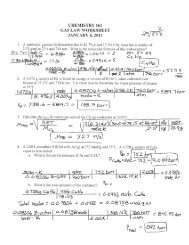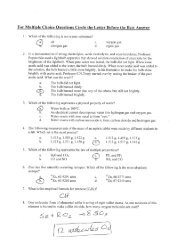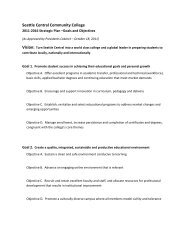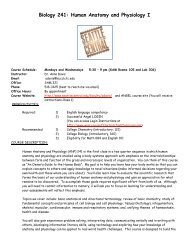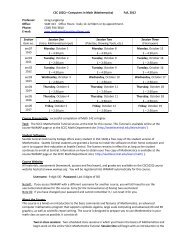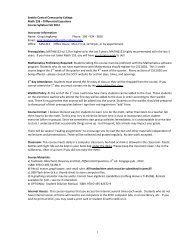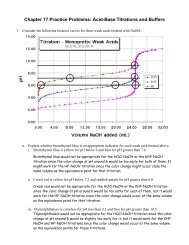Physics 201 Exam 2 Write also your name in the appropriate box of ...
Physics 201 Exam 2 Write also your name in the appropriate box of ...
Physics 201 Exam 2 Write also your name in the appropriate box of ...
You also want an ePaper? Increase the reach of your titles
YUMPU automatically turns print PDFs into web optimized ePapers that Google loves.
Name: ______________________________________________________________ Total Po<strong>in</strong>ts: _______(Last)(First)<strong>Physics</strong> <strong>201</strong><strong>Exam</strong> 2<strong>Write</strong> <strong>also</strong> <strong>your</strong> <strong>name</strong> <strong>in</strong> <strong>the</strong><strong>appropriate</strong> <strong>box</strong> <strong>of</strong> <strong>the</strong> scantron
Name: ______________________________________________________________ Total Po<strong>in</strong>ts: _______(Last)(First)Multiple choice questions [60 po<strong>in</strong>ts]Answer all <strong>of</strong> <strong>the</strong> follow<strong>in</strong>g questions. Read each question carefully. Fill <strong>the</strong> correctbubble on <strong>your</strong> scantron sheet. Each question has exactly one correct answer. Allquestions are worth <strong>the</strong> same amount <strong>of</strong> po<strong>in</strong>ts.1.A car travels east at constant velocity. The net force on <strong>the</strong> car is:A. eastB. westC. upD. downE. zero s<strong>in</strong>ce <strong>the</strong> acceleration is 0 and F net = ma.
Name: ______________________________________________________________ Total Po<strong>in</strong>ts: _______(Last)(First)2.A circus performer <strong>of</strong> weight W is walk<strong>in</strong>g along a "high wire" asshown. The tension <strong>in</strong> <strong>the</strong> wire is:H<strong>in</strong>t: Draw a free body diagram for <strong>the</strong> circus performer.A. approximately WB. approximately W/2C. much less than WD. much more than WDraw a free body diagram for <strong>the</strong> performerIt follows (with T <strong>the</strong> magnitude <strong>of</strong> <strong>the</strong> tension <strong>in</strong> <strong>the</strong> rope)−T rPLeftRopeW2 WPEs<strong>in</strong>ce θ is small.2s<strong>in</strong>θPEWPE+ T s<strong>in</strong>θ= 0 ⇒ T = ⇒ T >>E. depends on whe<strong>the</strong>r he stands on one or two feetW rPEθT rPRightRope
Name: ______________________________________________________________ Total Po<strong>in</strong>ts: _______(Last)(First)3.A 1-N pendulum bob is held at an angle θ from <strong>the</strong> vertical by a 2-Nhorizontal force F as shown. The tension <strong>in</strong> <strong>the</strong> str<strong>in</strong>g support<strong>in</strong>g <strong>the</strong>pendulum bob (<strong>in</strong> newtons) is:A. cos θB. 2/cos θC. s<strong>in</strong> θD. tan θE.5Draw a free body diagram for <strong>the</strong> bobT rBSF rW r BE22TBS = WBE+ F = 5N
Name: ______________________________________________________________ Total Po<strong>in</strong>ts: _______(Last)(First)4.A 70 N block and an 35-N block are connected by a str<strong>in</strong>g as shown.If <strong>the</strong> pulley is massless and <strong>the</strong> surface is frictionless, <strong>the</strong> magnitude<strong>of</strong> <strong>the</strong> acceleration <strong>of</strong> <strong>the</strong> 70-N block is:(Recall <strong>the</strong> similar computation done <strong>in</strong> lab)A. 1.6 m/s2B. 3.3 m/s2for <strong>the</strong> 35 N blockrWrr35E+ T35S= m35a35⇒ T35S= W35E− m35a35= 35 − m35a35And for <strong>the</strong> 70 N blockr r r rT70S + W70E+ N70T= m70a70⇒ T70S= m70a70Use thatT70 S= T35Sand a 70= a 35= a to get35m70a = 35 − m35a⇒ a == 3.3m/ s(70 + 35) / 9.82C. 4.9 m/s2D. 6.7 m/s2E. 9.8 m/s2
Name: ______________________________________________________________ Total Po<strong>in</strong>ts: _______(Last)(First)5.A horizontal shove <strong>of</strong> at least 200-N is required to start mov<strong>in</strong>g a 800-N crate <strong>in</strong>itially at rest on a horizontal floor. The coefficient <strong>of</strong> staticfriction is:A. 0.25200N is <strong>the</strong> m<strong>in</strong>imum force to accelerate <strong>the</strong><strong>box</strong>. Thus it is equal to <strong>the</strong> maximum force<strong>of</strong> static friction:200 = µs800 ⇒ µs= 0.25B. 0.125C. 0.50D. 0.75E. 1.00
Name: ______________________________________________________________ Total Po<strong>in</strong>ts: _______(Last)(First)6.A <strong>box</strong> with a weight <strong>of</strong> 50 N rests on a horizontal surface. A personpulls horizontally on it with a force <strong>of</strong> 10 N and it does not move. Tostart it mov<strong>in</strong>g, a second person pulls vertically upward on <strong>the</strong> <strong>box</strong>. If<strong>the</strong> coefficient <strong>of</strong> static friction is 0.4, what is <strong>the</strong> smallest verticalforce for which <strong>the</strong> <strong>box</strong> moves?A. 4 NB. 10 NC. 14 N25 NDraw a FBDD.f r BTN rF r vBEW r BT<strong>the</strong> normal force act<strong>in</strong>g on <strong>the</strong> <strong>box</strong> isNBT= WBE− FvWhen <strong>the</strong> <strong>box</strong> starts mov<strong>in</strong>g, <strong>the</strong> frictionF r hforce is equal to F hfBT= FhBut fBT= µSNBT= µS( WBE− Fv)Fh10⇒ Fv= WBE− = 50 − = 25NµS0.4E. 35 N
Name: ______________________________________________________________ Total Po<strong>in</strong>ts: _______(Last)(First)7.Which <strong>of</strong> <strong>the</strong> follow<strong>in</strong>g five acceleration versus radius graphs iscorrect for a particle mov<strong>in</strong>g <strong>in</strong> a circle <strong>of</strong> radius r with acceleration aat a constant speed <strong>of</strong> 10 m/s?A. 1B. 2C. 3D. 4E. 5 s<strong>in</strong>ceva =r2
Name: ______________________________________________________________ Total Po<strong>in</strong>ts: _______(Last)(First)8.A person rid<strong>in</strong>g a Ferris wheel is strapped <strong>in</strong>to her seat by a seat belt.The wheel is spun so that <strong>the</strong> centripetal acceleration is g. Select <strong>the</strong>correct comb<strong>in</strong>ation <strong>of</strong> forces that act on her when she is at <strong>the</strong> top. In<strong>the</strong> table, W PE = weight, down; F PB = seat belt force, down; and F PS =seat force, up.A. W PE = 0, F PB = mg, F PS = 0W PE = mg, F PB = 0, F PS = 0Draw a FBDF r PSB.rWPEr+ FPSr+ FPBF r PBW r PEr= maalong <strong>the</strong> vertical ( positive is down)mg − FPS+ FPB= mg ⇒ FPB= FPSB is <strong>the</strong> only possible answerC. W PE = 0, F PB = 0, F PS = mgD. W PE = mg, F PB = mg, F PS = 0E. W PE = mg, F PB = 0, F PS = mg
Name: ______________________________________________________________ Total Po<strong>in</strong>ts: _______(Last)(First)9.A crate moves to <strong>the</strong> right on a horizontal surface as a woman pullson it with a 10-N force. Rank <strong>the</strong> situations shown below accord<strong>in</strong>g to<strong>the</strong> work done by <strong>the</strong> 10-N force, least to greatest. The displacementis <strong>the</strong> same for all cases.3, 2, 1A. W = Fd cosθUseandθ= 0, θ2≈ 45, θ3B. 2, 1, 3C. 2, 3, 1D. 1, 3, 2E. 1, 2, 31=9010.A man pulls a sled along a rough horizontal surface by apply<strong>in</strong>g aconstant force F r at an angle θ above <strong>the</strong> horizontal. In pull<strong>in</strong>g <strong>the</strong>sled a horizontal distance d, <strong>the</strong> work done by <strong>the</strong> man is:A. FdB. Fd cos θC. Fd s<strong>in</strong> θD. Fd/cos θE. Can’t tell without know<strong>in</strong>g <strong>the</strong> coefficient <strong>of</strong> k<strong>in</strong>etic friction.
Name: ______________________________________________________________ Total Po<strong>in</strong>ts: _______(Last)(First)11.A particle is <strong>in</strong>itially at rest on a horizontal frictionless table. It is actedupon by a constant horizontal force F. Which <strong>of</strong> <strong>the</strong> follow<strong>in</strong>g fivegraphs is a correct plot <strong>of</strong> work W as a function <strong>of</strong> particle speed v?H<strong>in</strong>t: use <strong>the</strong> work energy <strong>the</strong>oremA. IB. IIC. IIID. W = Kf− Ki ⎫⎪1 21 2IV Kf= mv ⎬ ⇒ W = mv2 ⎪ 2Ki= 0 ⎪⎭E. V
Name: ______________________________________________________________ Total Po<strong>in</strong>ts: _______(Last)(First)12.The velocity <strong>of</strong> a particle mov<strong>in</strong>g along <strong>the</strong> x axis changes from v i to v f .For which values <strong>of</strong> v i and v f is <strong>the</strong> total work done on <strong>the</strong> particlenegative?A. v i = 2m/s, v f = 5m/sB. v i = –2m/s, v f = 5m/sC. v i = –5m/s, v f = 2m/sD. v i = 2m/s, v f = –5m/sE. v i = –2m/s, v f = –5m/s⎫W = Kf− Ki ⎪⎪21Kf= mvf ⎬ ⇒ W = m(vKi=1 2 2f− vi212mv2i⎪⎪⎪⎭2) ⇒ W< 0 ifvf
Name: ______________________________________________________________ Total Po<strong>in</strong>ts: _______(Last)(First)PROBLEM [40 po<strong>in</strong>ts]W<strong>in</strong>k<strong>in</strong>, Bl<strong>in</strong>k<strong>in</strong>, and Nod are identical triplets, each hav<strong>in</strong>g amass m = 30.0 kg. They clasp arms <strong>in</strong> a l<strong>in</strong>e and go out on toan ice-covered pond.W<strong>in</strong>k<strong>in</strong> grabs onto a post anchored <strong>in</strong> <strong>the</strong> ice with his freearm, and starts to go around <strong>the</strong> post. He soon reaches aconstant speed, where he makes one complete revolution <strong>in</strong> atime T = 6.28 s.The distance from <strong>the</strong> center <strong>of</strong> each boy to <strong>the</strong> end <strong>of</strong> his arm is 0.50 m, so that Nod’s body is 2.5m from <strong>the</strong> post and Bl<strong>in</strong>k<strong>in</strong>’s body is 1.5 m from <strong>the</strong> post. At <strong>the</strong> <strong>in</strong>stant shown, <strong>the</strong> boys are l<strong>in</strong>edup along <strong>the</strong> x-axis ( î ), and skat<strong>in</strong>g at constant speed <strong>in</strong> <strong>the</strong> negative y direction ( − ĵ , out <strong>of</strong> <strong>the</strong>page). The z-axis ( kˆ ) is vertical.1). [10 pts] If <strong>the</strong> boys’ arms stay rigid, what is Nod’s velocity as he goes around <strong>the</strong>post? Measure his velocity at <strong>the</strong> center <strong>of</strong> his body which is 2.5 m from <strong>the</strong> post.Give <strong>the</strong> direction, units and magnitude. Expla<strong>in</strong>.Nod is mov<strong>in</strong>g on a circle at constant speed. Nod makes one revolution = 2πr <strong>in</strong> T.2 rv = π = 2.5m/ sTAt <strong>the</strong> <strong>in</strong>stant shown <strong>the</strong> direction <strong>of</strong> Nod’s velocity is − ĵ (as mentioned above)2). [10 pts] What is Nod’s acceleration vector at <strong>the</strong> <strong>in</strong>stant shown (direction, units, andmagnitude). Expla<strong>in</strong>.The acceleration is toward <strong>the</strong> center <strong>of</strong> <strong>the</strong> circle and has magnitude v 2 /r (Nod is mov<strong>in</strong>g on acircle at constant speed).2r v2a Nod= ( −iˆ)= −2.5ˆi m / sr
Name: ______________________________________________________________ Total Po<strong>in</strong>ts: _______(Last)(First)3). [15 pts]What is <strong>the</strong> force F rBN<strong>the</strong> force with which Nod pulls on Bl<strong>in</strong>k<strong>in</strong>? Give <strong>the</strong>direction, units and magnitude. Expla<strong>in</strong>.r rAccord<strong>in</strong>g <strong>the</strong> Newton’s 3 rd law F BN= −FDraw a FBD for NodNBF rNBN r NINEW rrFNB= marN= −30 × 2.5×iˆ= −75ˆi NThusr= 75iˆNF BN4). [10 pts] What is <strong>the</strong> force F rBW<strong>the</strong> force with which W<strong>in</strong>k<strong>in</strong> pulls on Bl<strong>in</strong>k<strong>in</strong>? Give <strong>the</strong>direction, units and magnitude. Expla<strong>in</strong>.Draw a FBD for Bl<strong>in</strong>k<strong>in</strong>F rBWN r BIBEW rF rBNThe velocity <strong>of</strong> Bl<strong>in</strong>k<strong>in</strong> isrv B= −1.5 ˆjm / sThe acceleration <strong>of</strong> Bl<strong>in</strong>k<strong>in</strong> isThusrFBWr+ FBNr= maBr⇒ FBWra B= −1.5ˆi m / s2= 30 × ( −1.5ˆ)i − 75ˆ i = −120ˆi N



